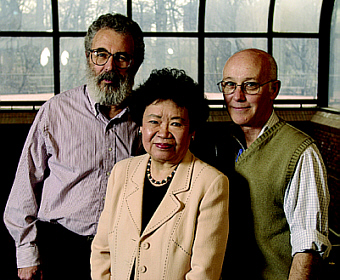Symposium to Gather JH Biologists

Allen Shearn, Biology Department
chair; Ru Chih, who will coordinate future events; and Doug
Fambrough, organizer of this week's neuroscience
symposium.
PHOTO BY HPS/WILL KIRK
|
Homewood's inaugural event will focus on
neuroscience
By Greg Rienzi
The Gazette
Scientists tend to live a blinkered, insular
existence, fixedly caught in the details of their research,
says Johns Hopkins biologist Allen Shearn. Shearn knows;
for nearly 32 years he's plugged away in his laboratory
focused on his work, relatively unaware of the work of the
person next door.
Now wearing the hat of
Biology Department
chair, however, Shearn understands it may not be a bad
thing to peek figuratively into a colleague's lab from time
to time.
In an effort to foster a more collegial,
information-sharing atmosphere among Johns Hopkins faculty
in the biological sciences, the Krieger School's Department
of Biology will host this week what it envisions as an
annual symposium to spotlight an area of research of
interest to the community. The event will take place from
8:30 a.m. to 1 p.m. on Wednesday, Jan. 21, at Homewood's
Mudd Hall Auditorium.
The featured topic for the inaugural symposium will be
the neurosciences, and five JHU faculty in the biological
sciences will give short presentations on their current
work.
Shearn said that when he became chair last July, he
quickly realized the need for greater synergy among
faculty.
"One of those things that always struck me about Johns
Hopkins is all these people doing interrelated research who
don't necessarily talk to each other, which I know is due
in part to the fact that they're so busy doing their own
research," Shearn said. "It occurred to me that we should
take a little time to exchange views on things that I know
people have a common interest in, and that an informal
symposium held during the intersession would be a good
mechanism for expressing these views."
The symposium will feature five roughly half-hour
talks by selected faculty who will present an overview of
their work and attempt to relate it to work being conducted
by colleagues.
The event seeks to draw faculty and students primarily
from the Homewood biology-related departments, including
Biophysics, Chemistry, Psychological and Brain Sciences,
Cognitive Sciences, the Mind/ Brain Institute, Biomedical
Engineering and the Embryology Department of the nearby
Carnegie Institution of Washington, whose scientists hold
joint appointments in the Department of Biology. The entire
Johns Hopkins community, however, is welcome, and Shearn
said he anticipates nearly 200 people attending.
This first year's group of talks will cover
neuroscience from the molecular level up to human language
(see below).
Douglas Fambrough, a professor of biology, will start
off the symposium with a short introduction called "Our
Neuroscience Community." Fambrough, who chairs the
symposium and selected the speakers, said neuroscience was
chosen to kick off the series in part because of the
aggressive stance the university has recently taken to
secure new hires in this field.
"Right now, neuroscience is a major area of
discovery," Fambrough said. "It is one of the most exciting
areas intellectually, period, and if Hopkins wants to be a
first-rate place in the next century, this is where the
biggest action is. We're talking about how the brain works,
how humans arise from genes and culture, and how this all
comes together to make people."
Fambrough added that he looked for speakers who were
"outstanding" in their science and could effectively share
the vision of their work.
Shearn said that the symposium is planned to become an
annual event with a different general topic each year.
Professor Ru Chih Huang will serve as the coordinator of
future events. Areas of focus, Shearn said, could be
biophysics or the interface between biology and
engineering.
"We see this as a chance for faculty to communicate
their work to an interested audience and to meet face to
face with those who are working in different departments
but who work in related areas," he said. "My main goal is
to improve communications between all those working in the
biological sciences at Homewood."
In this symposium, for example, one speaker will talk
about the development of the nervous system, and another
will address her work with lab animals and neural systems
that serve a role in memory and attention.
"There is clearly a relationship between the abilities
that animals have to learn and the development of the human
nervous system," Shearn said. "These are the sort of
relationships we hope people will find interesting."

Inaugural Homewood biology symposium 'Symposium on
Neurosciences'
When: 8:30 a.m. to 1 p.m., Wednesday, Jan. 21
Where: Mudd Hall Auditorium
Speakers and Topics
 Doug Fambrough, professor, KSAS Department
of Biology Doug Fambrough, professor, KSAS Department
of Biology
"Introduction: Our Neurosciences Community"
 Haiqing Zhao, assistant professor, KSAS Department of
Biology
Haiqing Zhao, assistant professor, KSAS Department of
Biology
"How Does the Nose Know? Activation, Deactivation
and Adaptation in Olfactory Sensory Neurons"
 Marnie Halpern, staff, Carnegie Institution of Washington,
Department of Embryology
Marnie Halpern, staff, Carnegie Institution of Washington,
Department of Embryology
"Genetic Approaches to Study Brain
Asymmetry"
 Michela Gallagher, chair, KSAS Department of Psychological
and Brain Sciences
Michela Gallagher, chair, KSAS Department of Psychological
and Brain Sciences
"Biology of the Aging Mind"
 Ed Connor, assistant professor of neuroscience,
Zanvyl Krieger Mind/Brain Institute
"Understanding Perception as Information
Processing"
Ed Connor, assistant professor of neuroscience,
Zanvyl Krieger Mind/Brain Institute
"Understanding Perception as Information
Processing"
 Brenda Rapp, professor, KSAS Department of Cognitive
Sciences
Brenda Rapp, professor, KSAS Department of Cognitive
Sciences
"Cognitive Science Approaches to Neuroscience: The
Cognitive and Neural Substrates of Written
Language"
 GO TO JANUARY 20,
2004
TABLE OF CONTENTS.
GO TO JANUARY 20,
2004
TABLE OF CONTENTS.
 GO TO THE GAZETTE
FRONT PAGE.
GO TO THE GAZETTE
FRONT PAGE.
|